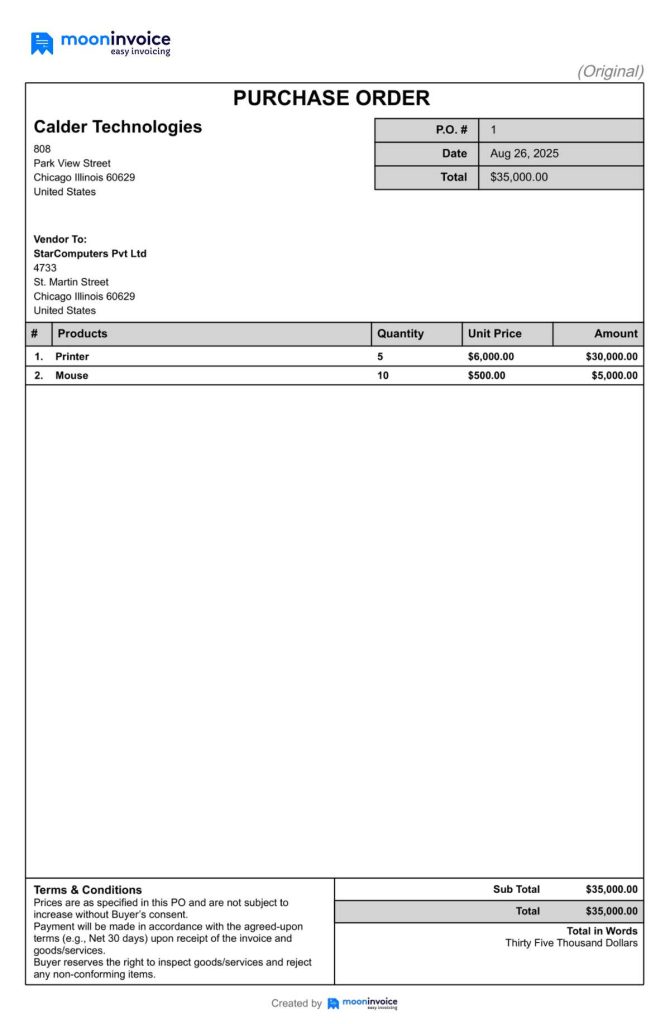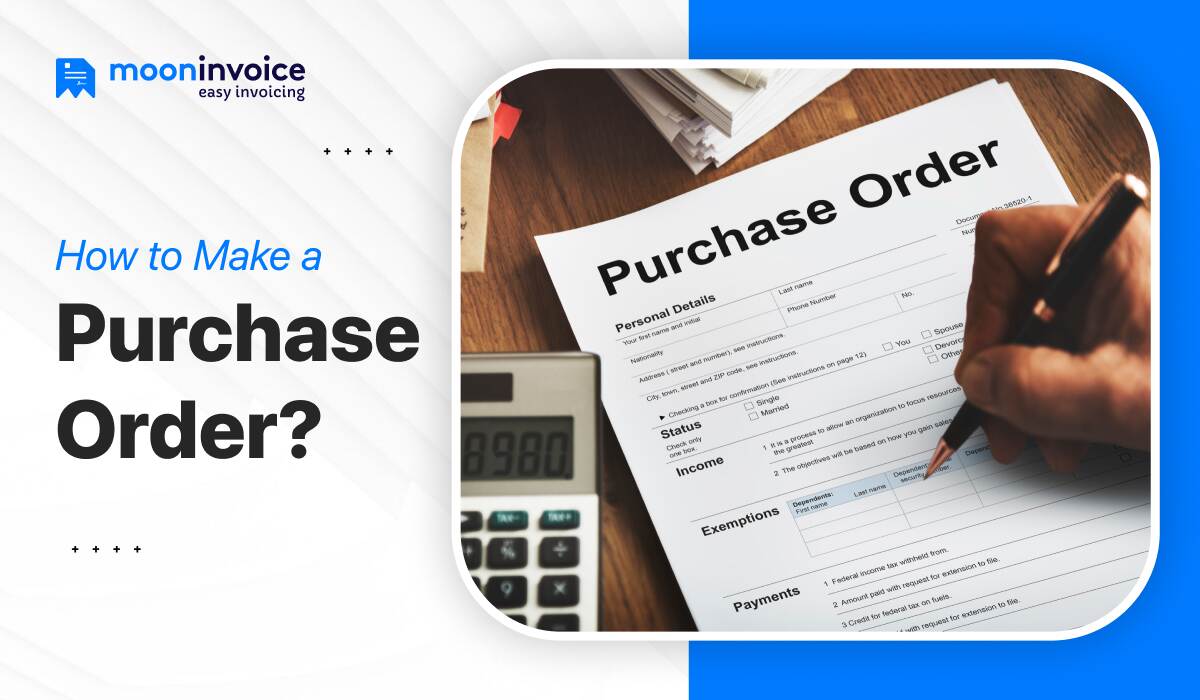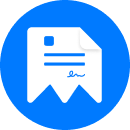The scenario of purchasing products and services is quite straightforward between individual end customers and vendors. Simply, the customer places an order, and the vendor fulfills it while charging the correct amount of money to the customer.
But is it the same when a business or organization buys services or products from a vendor? Not really!
Any business, whether a small, medium, or large enterprise, requires proper control over spending when making a purchase. A proper and correct capital administration is required. That’s where the need for a purchase order arises.
You may have heard about a purchase order many times before. Have you ever considered how to make a purchase order? The question perplexes many minds, as many professionals have no clear idea about it.
No worries! Our guide will teach how to create a purchase order. In further sections, you’ll get to know what a purchase order is, along with an example. Additionally, you will learn what details are required when creating a purchase order.
📌 Key Takeaways
- A purchase order is a formal document that the buyer shares with the seller/vendor.
- A PO becomes a legal document when the supplier approves the purchase order agreement. It also provides legal protection.
- Purchase orders are helpful for businesses to control finances, track spending, and prevent unauthorized expenditures.
- A PO document is an important component of three-way matching (PO, invoice, and goods received notes matched and compared for accuracy).
- The sample purchase order document also helps strengthen the supplier relationship during the purchasing process.
💡Do You Know?The global purchase order software market size is expected to reach USD 19.92 billion by 2034, according to Global Growth Insight.
What Is a Purchase Order?
A purchase order is a financial and legally binding document that the buyer sends to the vendor. It carries the details of goods or services to be purchased along with the pricing, items, and delivery conditions. PO is generated by the buyer after approval of the purchase request.
The primary purpose of a PO for the buyer is to specify the required product/service and submit a purchasing request to the vendor/seller. Businesses and organizations, as buyers, also use this document to track expenses and manage their budgets.
Several Types of Purchase Order
There are four types of purchase orders, each with its own purpose and characteristics. Here is the introduction of the same.
1. Standard Purchaser Order
The common PO format is useful in many cases. In this case, the buyer knows exactly what to purchase, along with the unit price, quantity, and delivery date.
2. Planned Purchase Order
These kinds of POs are useful when the buyer is clear about the items and cost. However, quantity and delivery date are unclear for several reasons.
3. Blanket Purchase Order
A blanket purchase order is useful for negotiating better pricing or securing a fixed delivery date in advance. Blanket POs are interchangeable with the planned purchase order.
4. Contract Purchase Order
Large enterprises typically use this type of purchase order during the purchasing process. It is a standard purchase order with the signature page.
Still Writing PO Details on Paper?
Digitalize your purchase order process with Moon Invoice. Fewer efforts but more effective!
Purchase Order Example
We here illustrate a PO example. The typical example represents the correct purchase order form, along with the details that can be generated using the free purchase order software.
Here is an example of a purchase order that outlines the details of the required items for the software company named “Calder Technologies.” The company is issuing the PO to the supplier StarComputers Pvt Ltd. The line item details include a comprehensive breakdown of products, along with their quantities and prices. Furthermore, it covers the terms and conditions.

Types of Purchase Orders You Must Never Consider
Sometimes, instead of using a digital purchase order system, professionals opt for available templates in Excel and Word.
However, this approach is not fruitful. Why? Here is the answer:
Free Purchase Order Template in Excel
Many professionals rely on Excel for creating purchase orders. However, it leads to errors and requires manual effort to fill in the values. Additionally, a professional should possess a good knowledge of Excel formulas. Thus, overall, it leads to increased time spent and an increased risk of mistakes.
Free Purchase Order Template in Word
Creating a purchase order in Word is another common practice among professionals. However, it still requires manual effort, such as using Excel. Additionally, tracking the inventory and spending is quite difficult in Word. There is a need for a separate system for this work, thus it adds an extra burden.
Manual Process Vs Digital Purchase Order
There are two methods for creating purchase orders: the manual approach and the digital approach. The manual approach includes paper-based PO generation. It means professionals need to plan and create the format from scratch and manually add the details.
Thus, it consumes a significant amount of time, as it requires 100% manual effort to create the purchase order. Additionally, it also leads to chances of errors. This could negatively impact the entire process and ultimately result in the business suffering.
Opting for a digital purchase order is a sophisticated and strategic approach to the purchase order process. It enables business professionals to create professional purchase orders in digital form. Unlike the traditional method, it helps professionals to generate POs while maintaining accuracy quickly. Professionals can generate unlimited Purchase Orders with a professional look. Thanks to the pre-defined purchase order templates offered by the PO-generating software, like Moon Invoice.
How to Make a Purchase Order Digitally? The Right Approach
Creating a purchase order is a straightforward process. Gone are the days when you create paper purchase orders. With all the new advanced approaches, you can streamline your PO process by creating digital POs through the right PO generator.
Here is the approach:
1. Identifying and Creating Needs
The initialization of the PO process begins with determining the needs with a proper procurement process. Buyers need to first clarify what to buy and in what quantity. Additionally, the buyer also needs to have clarity over the budget.
For the larger organizations, purchasing departments are required to perform these actions. They need to generate purchase requisitions and share them with the managers. Once they approve the requisition, the next step is generating the PO.
2. Get the Right Tool & PO Template
Don’t neglect the power of software and tools when you think over how to make a PO. Buyers can easily place a purchase order using the right PO-generating tools, such as Moon Invoice. It offers predefined templates to quickly build a purchase order. Users only need to fill in the details, and the system automatically generates a purchase order request. Additionally, the templates incorporate an auto-calculation feature that automatically calculates the total cost, including tax.
Additionally, it enables professionals to manage purchase orders efficiently. Professionals can easily convert a PO into a bill and make a duplicate copy in a single click. It’s handy to check the performed actions through the activity log option.
Additionally, users can easily modify the PDF & print settings as the platform offers highly customizable options. Mark PO as draft, received, sent, and approved easily from the defined options.
Do Unlimited Edits, Create Unlimited Purchase Orders
Utilize customized purchase order templates from Moon Invoice. Enhance your purchasing experience with speed.
3. Include the Details
Have you downloaded the free purchase order template? Great! Now, filling out the details is the next step in considering how to generate a purchase order approach. Since choosing the right purchase order template, it becomes easy to fill in the information.
3.1. Purchase Order Details
The purchase order details include the PO number, expected delivery date, currency, and the date the purchase order was generated. Here, every PO you create will have a unique PO number. This number is highly useful to track purchase orders.
3.2. Business Details
Showcase your business/organization details to the vendor/supplier. It includes the business name, address, contact information, and email address. It may also include the business owner’s personal contact information.
3.3. Supplier/ Vendor Details
Please provide the details of your vendor or supplier, including their name, address, and contact information. This makes it clear to whom you are making & sharing the PO.
3.4. Shipping Details
If the business is purchasing goods from another state or country, then shipping information is required. It should cover street address, state, country, and zip code. You can also use the same address as the billing address if a separate shipping address does not exist.
3.5. Line Item Details
Mention the line item details, including the product or service name, quantity, and unit price. It is highly recommended to present the details in a bifurcation form, along with a cost breakdown.
3.6. Add the Terms
Buyers need to add the terms and conditions in accordance with the business norms. Clearly state the payment terms, such as Net 15, Net 30 & Net 60, shipping terms (if applicable), and any other crucial terms. Keep the language clear and easy to understand for the viewer. This helps reduce confusion. Highlighting important terms is another good practice to follow.
3.7. Authorized Signature
At some organizations or industries, it is necessary to mention the business owner or any other authorized person’s signature on the PO. When you use a manual approach, you only have the option to sign the PO manually with a physical signature.
However, with purchase order software like Moon Invoice, you can easily add your digital signature. It is also possible to put the physical signature on the purchase order after printing a copy of the PO.
4. Review Details & Send to Selected Vendor
Once all the details are added, review them. Cross-checking all the details is helpful in identifying the errors. Thus, your PO is highly accurate and helps reduce any confusion and disputes that may arise in the future.
When all the details are in order, the next step is to send the purchase order to the vendor. Professionals can easily send the purchase order via WhatsApp or email in Moon Invoice.
Once the seller/vendor receives the PO, they deliver the product/service along with the related invoice & align it to that PO. Once you receive an invoice, you are expected to make payment in accordance with the payment terms. For instance, if the seller uses the Net 30 payment method and sends the billing document using the Net 30 invoice template, then you must make the payment within 30 days of the billing date.
Create an Accurate Purchase Order & Level Up Your Business Purchasing
Explore varieties of ready-to-use PO formats with automation. Simplify your purchase order process!
5 Best Practices for a Smooth Purchase Order Process
1. Utilize PO Templates
PO templates are a professional format with pre-defined fields that help to streamline the PO-making process. It enables users to create a sample purchase order in less time with all professional and clear formats. Templates are very useful in enhancing the purchase order process.
2. Keeps the Language Easy
When creating the purchase order, keep the language simple. Unprofessional and unclear language can ruin your PO game. Add a high level of clarity in accordance with your business policy. For instance, if your business operates on Net 30 terms, you must clearly state Net 30 payment terms in your terms and conditions.
3. Opt for Automation
Incorporating automation in the purchase order creation process is quite beneficial. This enhances the overall process. Automation led to a fast and accurate process that helps to save time. Additionally, it gives a cost-effective solution & enables professionals to save money that is not possible in the manual process.
4. Maintain Records
Keeping a record of data is a good practice in the business world. This also applies to the purchase order. Maintaining a proper record of purchase orders helps the business to smooth its tax compliance, audits, and financial reporting.
5. Opt for a Centralized System
Choosing a centralized system can streamline the PO process. It helps business professionals to maintain a systematic approach to accessing the details. Large enterprises should always adopt a centralized system.
We End Here
The guide on how to create a purchase order is now being finalized. A purchase order is a crucial document that enables businesses to track expenses accurately when purchasing the necessary items. Additionally, it helps to maintain optimal inventory levels while preventing stockouts and overstocking.
Creating a purchase order can be a task of minutes when choosing the right invoicing tool, such as Moon Invoice. The platform gives the easiest approach to accurate PO generation. Do you want to experience it? Yes, we welcome with a Free Sign-Up!



















